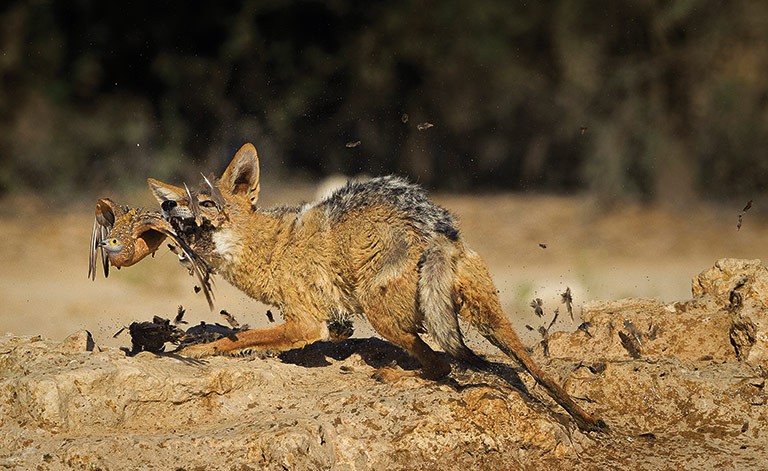Jackals, caracals and leopards are predators that plague farmers. But removing predators from ecosystems has cascading negative effects. Soon we will be able to encourage farmers to make the ethical choice – with our wallets, writes environmental journalist Lee Middleton.
Also read: Should we breed captive lions to save the wild ones?

What do your next braai, a farmer’s dog-food bill and a prematurely randy jackal have in common? Not enough at the moment. But that might change with the introduction this year of a wildlife-friendly livestock label. Marketing meat you don’t have to feel guilty about, such certification will give consumers a choice that could be the beginning of the end of an age-old war waged by farmers on predators.
People have battled wildlife for turf ever since we got into the business of planting fields and domesticating animals. But concern over how our food is produced is growing these days, evidenced in things like this dramatically titled online petition ‘Stop the Barbaric Culling of Jackals and Caracals’. Addressing a Western Cape policy that permits farmers to exterminate five of each species per day, the petition particularly took issue with the indiscriminate methods allowed, namely hunting and gin traps. Though CapeNature hotly disputes the numbers of predators killed, the petition raised the question: do farmers who fight fair have a fighting chance?
‘It’s a topic that’s been around for 300 years – it’s still unsolved,’ says Dawie Burger of Driehoek Farm as his Anatolian sheepdog lopes past. A massive white beast whose dark muzzle sheaths the strongest jaw in the canine family, Tierman barked at the resident horse and pig on his way to the kraal, which he inspected before 30-odd sheep trotted in for the night. Sponsored by The Cape Leopard Trust after a leopard massacred 14 sheep in 2004, Tierman and his predecessor have prevented predation on Driehoek since their arrival. Though dogs have worked well at Driehoek, they must be rigorously trained, kept apart from other dogs, and cared for (feeding can be a deal breaker on larger farms with flocks scattered across the veld). Dawie points out that no single method works for every farm, and even on the same farm, techniques must be changed as predators adapt. Which is to say, there is no silver bullet, lethal or otherwise.
‘We’re constantly fighting nature instead of understanding biology and adapting our practices to the natural system,’ says Jeannine McManus, research and field manager at the conservation organisation, Landmark Foundation. With much of the Cape’s natural habitat disturbed, and top predators and many prey species wiped out, the predators that remain – jackal and caracal are common, leopard exist in small pockets – are nothing if not adaptable.
‘We don’t know what the next problem will be, but without a doubt there will be a problem,’ McManus says, referring to the cascading effects of removing predators from ecosystems.
Commenting on the theoretical destruction of the Cape’s remaining predators, McManus lists potential scenarios including dassie and rodent populations exploding, causing massive seed consumption and vegetation loss, leading to desertification and groundwater problems. Or, what has been observed in the Karoo: jackals going into heat earlier, and producing litters double or triple the usual size, ultimately resulting in even more jackals.
According to McManus’ research – the first of its kind in South Africa – farmers using non-lethal controls had more livestock survive than those using lethal methods, ultimately spelling greater financial returns over a three-year period. So why doesn’t everyone jump on the bandwagon?
‘We’re on the edge, but still others [farmers] will tell me kill everything,’ notes Dawie about the tradition of killing predators, which is compounded by the practical reality of upfront costs. Given all the other variables such as weather, politics and global markets, it’s understandable that farmers aren’t lining up to change and take on what seems like additional risk.
Which is where consumers come in.
‘It has to knock on back to the guy who has to make that decision: is he going to poison or use dogs? The majority will make a financial decision. Sometimes that’s a perceived benefit, but we want to make it explicit,’ explains Bool Smuts, director at Landmark Foundation, which has developed a ‘Fair Game’ label that will give its markup back to the producers. Meanwhile Woolworths is also on its own journey to put wildlife-friendly lamb on its shelves. ‘We think our customers care about biodiversity loss, climate change, and ethics. But we’re doing it because it’s the right thing to do. Let’s hope customers follow,’ says Tom McLaughlin, Woolworths’ food sustainability manager.
Back in the Cederberg, Dawie Burger is contending with baboons ravaging the vineyards daily. He is pro-conservation, but insists that farmers must be able to choose methods that are both humane and effective. ‘I’m between red and green – yellow. A robot is yellow. You still can go or not go. Make a choice,’ he says. Indeed, we can all do that.
Current practice
Ethical management works to deter predators, but if this fails, the focus is on problem individuals.
- Guardians – Anatolian dogs, alpacas, llamas, donkeys, ostriches or ‘eco-rangers’ – old-fashioned shepherds.
- Ambient deterrents – Devices that scare predators by emitting a sound, smell or flashing light.
- Protective fencing – Used to enclose kraals, particularly in lambing or calving seasons.
- Wire-mesh collars – Known as ‘dead-stop collars’ which protect animals from attacks to the neck, typically where carnivores bite.
What’s ethical?
The most commonly used lethal methods.
- Gin traps – Renamed ‘soft traps’, these leg-holds are planted under fences and along animal paths, and capture whatever crosses them. Those captured often die of dehydration or suffer gangrene. The rubberised jaws are less malicious than the jagged teeth of yore, but calling them ‘soft’ is pure spin. Status: legal.
- Hunting with dog, from helicopters and by ‘call and shoot’ – Recordings of injured or young prey are played to attract predators. All these methods are often used indiscriminately. Status: legal.
- Poison – Usually deposited in baited meat, this method is indiscriminate and can kill livestock and pets. Status: illegal.
This article first appeared in the June 2015 issue of Getaway magazine.


















